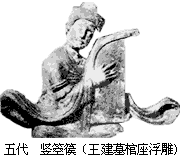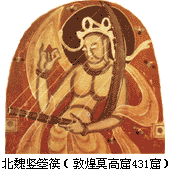Kōng Hóu
This is another ancient plucked instrument. It has three types: horizental, vertical and those with a phoenix head. It has a wide range, clear, soft and beautiful tone color and is very expressive. It was not only used in the “graceful music” in imperial courts, but also among common folks as solo, ensemble with other instruments and in a big band.

A Kong Hou, believed to have existed around 500 B.C. was excavated in 1996 in Xijiang, the most north-west region of China, another one, believed to have existed around 700 B.C. was discovered in 2003 in the same region.We can see the Kong Hou in frescoes from Han to Northern Wei Period (206 B.C.-534), for instance, the fresco in Cave  431 at Dunhuang Mogao Caves, as Shown on the right, is identical to those (harps) on the basso-relievo of Assyria.
431 at Dunhuang Mogao Caves, as Shown on the right, is identical to those (harps) on the basso-relievo of Assyria.
Aside from vertical Kong Hou, there were also smaller ones, which can be held by the left hand and plucked by the right hand. Such smaller ones were often used in protocol music marchings, as show below, which is also a fresco in cave 390 at Dunhuang Mogao Caves.

Famous Kong Hou Pieces
《Missing the Secular World》, a modern piece that depicts how a buddhist nun misses the secular world.
《High Hills and Surging Waters》
《Three Variations of Plum Flowers》
《Singing on Fishing Boats at Dusk》
《Bamboo of Madame Xiang》,composed by a contemperory Kong Hou lady master Cui Junzhi. This piece sings praises of a special kind of bamboo, which has red dots on its leafs and is named after two ladies—wives of Emperor Shun (before 21st century B.C.). It was said that there were nine evil dragons living on Mount Jiuyi. They often played in the water of Xiangjiang River. Their playing caused serious flood that ruined crops and houses, and the common folks suffered a great deal. Emperor Shun decided to go to the south to conquer these dragons, he said good-bye to his two wives, who were daughters of his predicessors. The wives waited for a triumphant return of their husband. But years passed, flowers abloomed and withered, yet there was no news at all. Finally they decided to go and look for Shun. They climbed one mountain after another and crossed one numerous rivers. They reached Mount Jiuyi and looked at every village, there was no trace of Shun. One day on their way, they saw a big tomb covered by pearls. They asked the locals, “Whose tomb is this? Why there are three huge stones behind the tomb?” They were told, “This is the tomb of Emperor Shun who came here from far north, he wiped out the nigh evil dragons for us; but he shed his last blood and died of illness here.” The tomb was built by people on and around the mountain; a group of cranes was touched by what Shun did, they carried from Southern sea pearls in their mouth and dropped them over the tomb. The three pieces of rock were transformed from Shun’s three teeth-fork, with which he faught the dragons. Hearing all these, the two wives were so sad, they cried for 9 days and nights, blood flew out from their eyes when tears were dried up. They finally died beside their husband. People then called them Madame Xiang, the name of the River. It is said that the red dots on bamboo leaves were the blood from the eyes of the two wives.
《Miluo River Reverie》, a Kong Hou concerto, adopted from Zheng concerto, which was composed especially for the Asian Composers’ Meeting in 1981 by Li Huanzhi. Miluo River is where the first Chinese poet Qu Yuan drowned himself, before his death, he wrote the first long lyric of China--《Grievance》. Qu lived in the Warring States period, seeing his own state—Chu was going to fall, and his proposals for the state to become stronger were turned down, he chose to end his life. People all over China remember him on the 5th of May, lunar calendar, by eating “Zhong Zi”, a reed leaf wrapped sticky rice, which was thrown into the river right after his death to dry to keep him from being eaten by fish. Since then May 5th has become a traditionnal festival.
《Peacock Flys to the Southeast》, a Kong Hou concerto based on an old poem about dedicaiton to love.
